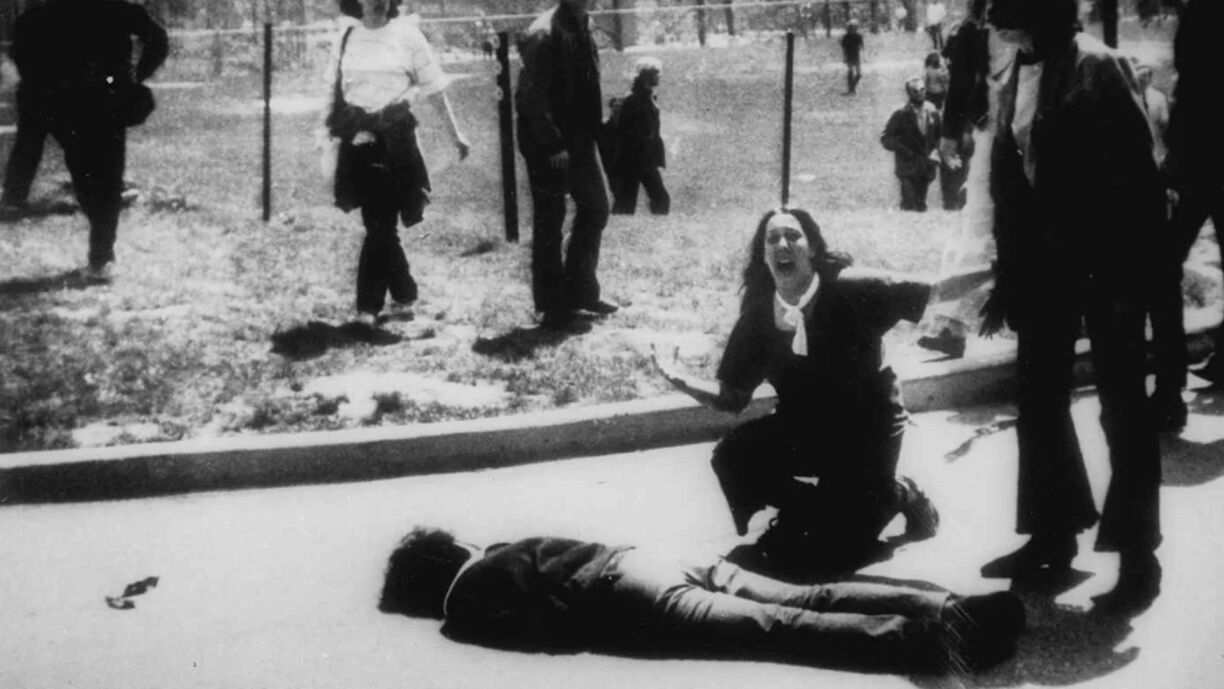
The small town of Kent, Ohio, situated about 50 km southeast of Cleveland became the tragic scene of senseless violence. It was also on that day that John Filo took his award-winning picture, that became one of the most relevant photographs of the 20th century.
On 30 April 1970, president Richard Nixon announced that U.S. and South Vietnamese troops were mounting a major invasion of Cambodia, after previously promising to end this war and scheduling the retreat of over 150,000 troops.
This quickly caused copious protest across the country. The following day, at Kent State two rallies were held at The Commons, a grassy open area at the centre of the campus. About 500 people attended and they symbolically burned a copy of the US constitution, which they said had been murdered by Nixon. They also called for another anti-war rally to be held on the coming Monday 4 May.
However that same evening a group of students fueled by alcohol and rage, took to the street and burned the contents of a garbage can. When law enforcement came to clear the streets, the revelers began breaking store windows. More than a dozen individuals were arrested and the remaining students were driven back to the campus by police in riot gear.
The next day on 2 May at about 8pm, around 1,000 people gathered in front of the Reserve Officers’ Training Corps (ROTC) building. The ROTC is an elective military education program hosted by colleges and universities that prepares students to be commissioned as officers in the U.S. armed forces. Some of the demonstrators set that building on fire. As firefighters were trying to put control the fire, their fire hoses were pulled and slashed.
By 3 May, nearly 1,200 National Guardsmen, a reserve military group, were deployed and occupied the campus. James Rhodes, who was Governor of Ohio at the time, came personally to the scene. He promised to use every part of the law enforcement agencies of Ohio to drive dissident groups out of Kent. He characterised the demonstrators as the “communist element,” night riders, and vigilantes.
While the Governor wasn’t able to initiate a state of emergency officially, it was widely assumed that the national guard would have control of the college campus rather than the university officials. Demonstrations were banned and 12.000 leaflets had been distributed. Still, about 3000 students congregated in and around the Commons of Kent State University on 4 May 1970.
Of the 3,000 students, only about 500 were actively protesting Nixon’s planned attack and were confronted by about 100 Guardsmen with loaded rifles. They managed to disperse the crowd but they still felt threatened enough that at 12pm, 28 Guardsmen fired around 60 shots in 13 seconds. Most of these went into the air or at the ground, but a number of men fired into the crowd.
Four students were killed and nine others were wounded. Only two of the killed students, Jeffrey Miller and Allison Krause, were part of the protests the other two, William Schroeder and Sandra Scheuer, were just bystanders on their way to class. The crowd was enraged and the threat of another shooting was palpable. At this explosive moment faculty marshals, led by Glenn Frank, a geology professor, successfully persuaded the students not to endanger their lives by taking on the Guard. The Commons was evacuated and the university closed for six weeks.
The US magazine Newsweek reported on this story with the headline “My God! They’re Killing Us.” and John Filo’s striking photographs. The death of the students led to a surge in anti-war protest across the country and the whole world, which in turn hastened the end of the selective service draft and the Vietnam War.
The commission created to examine the Kent State Shooting concluded that the Guardsmen’s “indiscriminate firing” was “unnecessary, unwarranted and inexcusable” but that “violent and criminal” actions by the demonstrators contributed to the tragedy.
In October 1970, 24 students and one faculty member were criminally charged, primarily for burning the ROTC building. In August 1973 eight former Guardsmen were charged with violating the civil rights of the students; they were however acquitted. Eventually the victims of the shooting received 675,000$ in settlement money from the state of Ohio.
While evidence that there was a command to shoot, or at the very least a conspiracy to shoot by some Guardsmen, came to light over the years, nothing else came of it.
Ever since 1971 the anniversary of the shooting has been commemorated at the Kent State campus with a candlelight procession and an all-night vigil, to commemorate the lives that were lost and those that were forever altered by what happened.